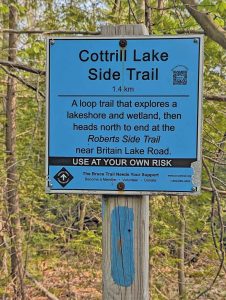Submitted by Peninsula Bruce Trail Club
What does two-eyed seeing mean? “Two-Eyed Seeing, or Etuaptmumk (in Mi’kmaw), is an approach to learning and science that braids both Indigenous and Western knowledges and ways of knowing.” (Bardwell, B.,Woller Skar, M.M., Challenges and successes of using Two-Eyed Seeing to teach Indigenous science at a predominantly white institution, June 2023). The ideology of colonization promoted the superior value of western based science, often disregarding the validity of Indigenous knowledge and worldview. By using both perspectives and ways of knowing, we build on the strengths of both worlds. As we consider the current social and ecological environment, different ways of knowing are crucial to helping us understand the past and moving forward to solve complex problems.
Peninsula Bruce Trail Club will be offering three “two-eyed seeing hikes” at Lion’s Head Nature Reserve. As you hike the Bruce Trail with Caley Doran, Indigenous Trail Guide and Layna Lubimiv, Chief Park Naturalist, MacGregor Point, you will learn about using a two-eyed seeing approach to understanding and protecting nature.
During your hike, you will also participate in a community science project – collecting litter and data regarding the litter – for the Bruce Trail Conservancy. Data regarding litter found on the Peninsula Section of the Bruce Trail (and access points) will be analyzed at the end of the season. We will finish the hike with a group conversation about your experience and talk about what you have learned. This hike is a moderately paced hike covering uneven terrain.
“Why would a hiking club be interested in two-eyed seeing?”
The Peninsula Bruce Trail Club (PBTC) is the most northern club of the Bruce Trail Conservancy (BTC). We have a dual mandate. One mandate is to maintain and promote a public footpath (the Bruce Trail) along the Niagara Escarpment for everyone to hike. Being a land trust is the other. Therefore, PBTC is more than a hiking club – also focusing on our relationship to the land through land stewardship and protection.
BTC and PBTC is grateful to the Saugeen Ojibway Nation (SON) – Chippewas of Nawash and Chippewas of Saugeen, who have traditionally cared for this land. We have much to learn from an Indigenous worldview – including conservation practices. By learning more about Indigenous worldviews, we will increase our understanding of the natural world and foster relationships built on trust and reciprocity – with each other and with Mother Nature.
If you would like to learn more about two-eyed seeing, register for one of the two-eyed hikes here: https://www.pbtc.ca/hikes
Peninsula Bruce Trail Club launches QR Code Side Trail Project this Summer!
By Brenda Stewart,
Archivist, Peninsula Bruce Trail Club
Have you ever hiked on one of the side trails in the Peninsula section that was named after an individual and wondered, “Who was this person, and why was this trail named after them?” The PBTC is launching a new side trails project which will hope to answer that question.

The Peninsula Bruce Trail section has over 70 side trails covering more than 100km. Twenty-five of these trails are named after people. The club is launching a project that will have QR code stickers affixed to the side trail signs on these trails. You can scan the QR code with your phone to hear an audio clip telling a short story about why the trail was named after that person, or you can follow a link to a webpage on our website to read the story and see a picture of the individual.
Currently we have 4 side trail “snapshot stories” which will launch early in the summer. These are the John Appleton Side Trail, the Beth Gilhespy Side Trail in the Barrow Bay area, the Donna Baker Side Trail near Lion’s Head, and the Gord Cottrill Side Trail near Dyer’s Bay. More trails will be added to the QR code project as the background stories are developed.
In the future we also hope to have QR codes highlighting the biological diversity or geological features of the trails.
We hope you will try out one of these new QR code trails over the summer, and that it will inspire you to learn more about the wonderful volunteers and individuals who have helped make the Peninsula Bruce Trail the outstanding recreational trail that it is.
For more information, or if you would like to volunteer to help with the project, please email pbtcarchives@gmail.com







![PBTC-#10-23-Caley-at-Lion's-Head-Nature-Reserve-August-15_22---Marg-Glendon[75]](https://brucepeninsulapress.com/wp-content/uploads/2023/06/PBTC-10-23-Caley-at-Lions-Head-Nature-Reserve-August-15_22-Marg-Glendon75-696x792.jpg)







